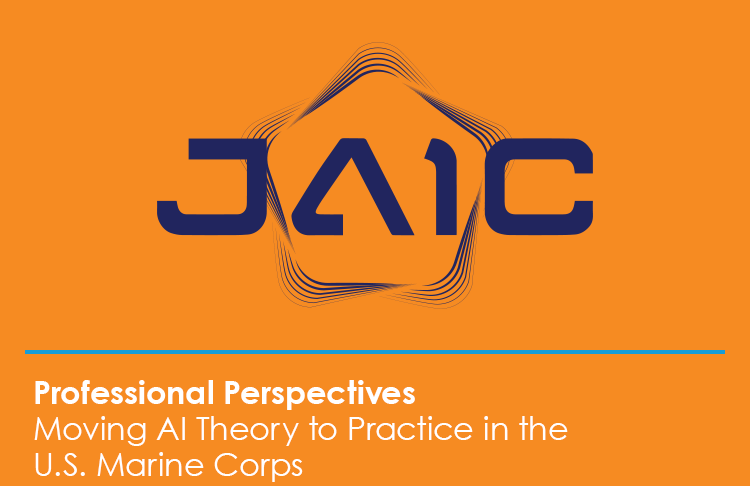Professional Perspectives
Moving AI Theory to Practice in the U.S. Marine Corps
- By: The JAIC

Our greatest enablement—or competitive advantage—will be in any effort that maximizes the cerebral ability of U.S. Marines at all echelons. This means reducing their cognitive burden, and leveraging our Marines to complete tasks for which humans are best suited. Artificial Intelligence can free up and elevate our Marines’ intellectual output, but this first requires a significant investment in people, data and infrastructure, and shortly thereafter a redesign of our methods and doctrine.
“Our current force design, optimized for large-scale amphibious forcible entry and sustained operations ashore, has persisted unchanged in its essential inspiration since the 1950s “ --CMC 38 Force Design 2030
The promise of a force re-design will never be realized if these new concepts of organization, technology, and training are made while ignoring the technical and talent investments required to bring such vision to fruition. In fact, the Department of Defense is working its own challenges with digital readiness, and the Marine Corps is perhaps the most challenged in terms of technology and digital talent. This is particularly important to the logistics community, on which the Marine Corps relies to sustain it, and retain and replenish combat power. Our current logistics systems are little more than digital white boards. This is a far cry from the plethora of technologic capabilities that we enjoy in everyday life. The status quo of logistics decision support tools will become less effective as the complexity and speed of warfare, and the quantity of data increases.
Our force design has come at a time when technology is able to supplement human intelligence, and commercial industry has largely completed their digital transformation journeys and are reaping the benefits. The Marine Corps is arguably the most fiscally constrained. By investing in the foundational efforts required to leverage AI, we can create the richest environment for our people and platforms to be AI-ready. Once the foundation for AI is developed, the operational opportunities can be realized. Most AI ‘projects or pilots’ are focused on the novel, a singular output for a discrete function. However, those efforts re-learn the difficult lessons paved by Project Maven and the Joint AI Center on operationalizing AI. Invest in the data, people, and infrastructure first; automate as much as possible; modernize through existing programs of record vice creating a new bureaucracy; all to ensure speed and relevance.
We must create capability, not PowerPoint presentations. We should experiment with that AI capability during exercises, not publish another concept document about “What AI could do for the USMC”. While most focus on the theory of ‘what AI could do’, we should instead heed the advice from industry: the up-front investment in data and people is always underestimated, and do not become enamored with the proverbial dashboard. We missed our opportunity to evolve incrementally, and must now make a revolutionary leap.
Major Zach Lucas is a Logistics Officer, and Major Dan Tadross is an Air Traffic Control Officer; both are Marine Corps Officers and are assigned to the Joint Artificial Intelligence Center (JAIC). The views expressed within this article are theirs alone and offered on this blog as professional perspectives on how to advance and scale AI in the Marine Corps.